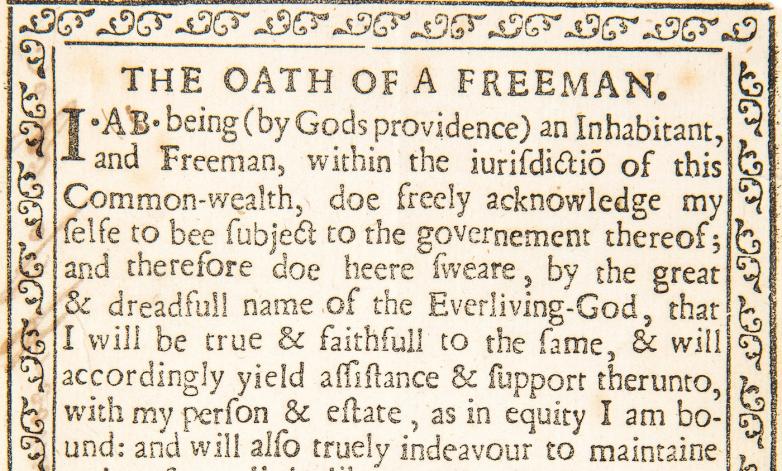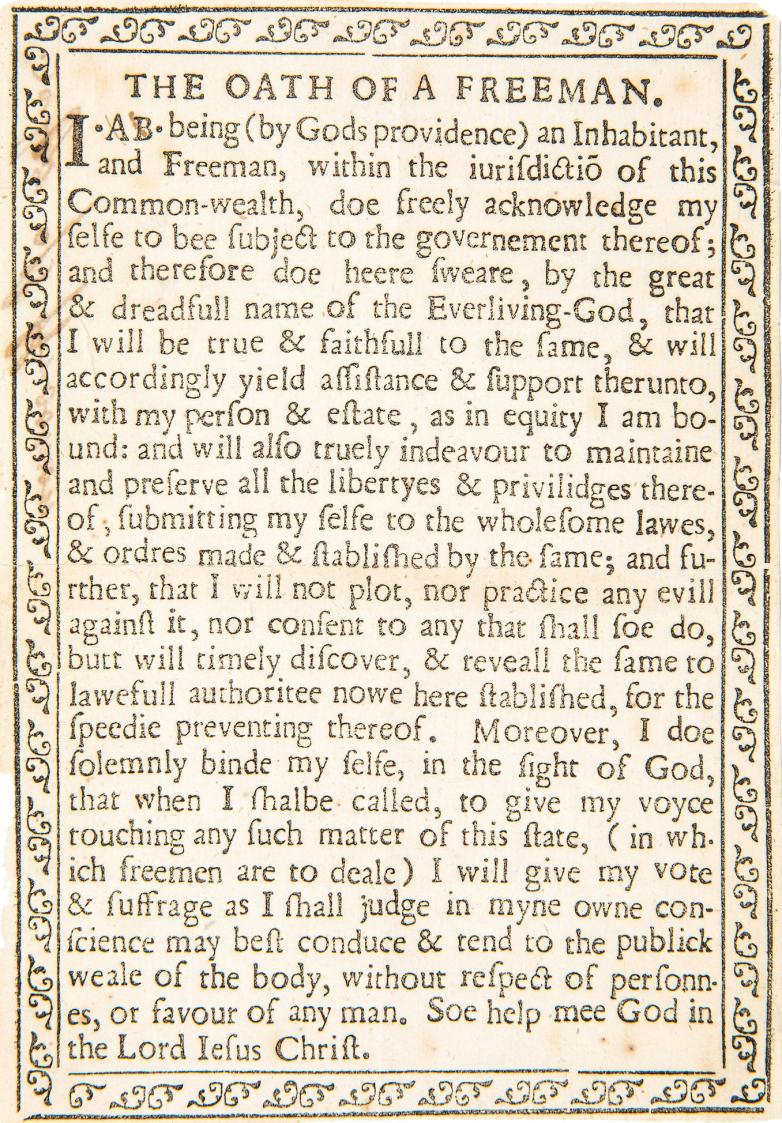The Oath of a Freeman, says the documentary’s co-director Tyler Measom, “is Hofmann’s Mona Lisa. It’s a remarkable forgery and, in and of itself, a piece of artwork.”
It was Hofmann who, in 1984, claimed to have discovered the so-called Salamander Letter and other “lost” writings that threatened to unravel the history of The Church of Jesus Christ of Latter-day Saints and cause irreparable damage to Mormonism. Hofmann was taken seriously, as he was a dealer of American history. But far more significantly, he was a maker of it, too, in his Salt Lake City home.
There, in his basement workroom, Hofmann fabricated the Mormon documents he sold to the Church. And there, in the spring of 1985, Hofmann printed The Oath of a Freeman, a 4-inch-by-6-inch document that looked so authentic it fooled scores of scholars, researchers and even one renowned chemist and microscopist. The forgery is such a masterwork that it has been the subject of several books, and, for a moment in the spring of 1985, was something the Library of Congress seriously discussed acquiring.
Hofmann’s The Oath of a Freeman will be sold during Heritage Auctions’ June 9-10 Rare Books Signature Auction, in the very slipcover made by the Library of Congress as it considered purchasing the document.
The Oath is being offered by renowned antiquarian bookseller Justin Schiller, who in 1984 helped Hofmann acquire rare books in private sales and at auction. Hofmann wound up owing Schiller and his partner Raymond Wapner more than $300,000, a debt not likely ever to be repaid.
In the spring of 1985 Hofmann owed so much money to so many people, and presented The Oath of a Freeman to Schiller in the hopes he would find someone willing to pay a fortune for the forgery. Hofmann claimed to have discovered the document tucked away in the Argosy Book Store in New York, where, in fact, he’d planted the forged copy. Hofmann said he paid $25 for the priceless artifact, and had the store provide him with the receipt to prove it.
Hofmann immediately took the sheet of paper to Schiller, and offered to split its proceeds with him 50-50 – if, that is, they sold The Oath for more than $1 million. It was Hofmann’s brilliant way of hooking the bookseller, who had an equal stake in proving it was The Real Thing.
Schiller would spend months, and an exorbitant sum, hoping to prove The Oath’s authenticity. And were it not for one forensic document examiner and two murders, Hofmann might well have gotten away with one of the greatest frauds in American history.
“With all its notoriety,” Schiller says of The Oath, “you could call it the most famous 20th century American forgery.”
But, of course, in March of 1985, Schiller still believed it was the real thing, and contacted the Library of Congress and the American Antiquarian Society, informing them that this mythic document existed. By early April, both entities had laid eyes upon The Oath, and by late May the Library of Congress’s Conservation Office issued a report that said its scientific studies “revealed no evidence that would contravene a mid-seventeenth century date for the broadside.”
It seemed, at least at that moment, that Hofmann had gotten away with it.
But in his 1991 collection of essays and documents about The Oath titled The Judgement of Experts, James Gilreath – once, an American history specialist in the rare books division at the Library of Congress – noted that the Library never actually confirmed this was the real thing. Far from it. Instead, Gilreath wrote, “its investigators merely stated that they could find no evidence of forgery based on their examination of the material used to make the document.”
But that report was all Schiller needed to justify sending the Library a written offer for the Oath – asking price, $1.5 million. As Measom notes, there was even talk of displaying The Oath of a Freeman next to the Declaration of Independence and the Constitution. But in June 1985, officials there turned it down, “because of questions about its price, provenance and title,” Gilreath wrote. And so it fell to the American Antiquarian Society, which, in September 1985, offered to buy the Oath for $250,000. Schiller and Wapner rejected the offer, insisting it was worth at least $1 million.
And so Hofmann set about making a second Oath, selling interest in the twin phony to his brother-in-law and a Utah businessman. His debts, in the hundreds of thousands, were mounting. He needed the money.
Then, on October 15, 1985, Hofmann became a murderer, using nail bombs in two separate incidents that terrorized Salt Lake City. He killed rare-documents collector Steven Christensen, who had bought the Salamander Letter from Hofmann, and Kathleen Sheets, the wife of Christensen's business associate. Hofmann was injured while transporting a third pipe bomb. Some thought it a distraction; others would later theorize he was trying to take his own life.
Hofmann would later confess that had he sold The Oath, he never would have committed the killings. In time, The Salt Lake City Tribune would come to describe Hofmann as “an evil genius and a fraud who deceived his church, his friends and even his wife.”
But just month after the killings, the headline remained the discovery of The Oath.
In November 1985, The New York Times reported “Gallery Said to Possess First American Imprint.” It detailed Schiller’s discussions with the Library of Congress and noted that a study conducted by the American Antiquarian Society “found no flaws in the document during the two months that it was in its possession last summer.” The society’s then-director told the paper that ''as far as we know, there were no anomalies” with The Oath.
In fact, as longtime Salt Lake City Police Department Crime Laboratory director George Throckmorton would later note, the document was authenticated repeatedly – including by the FBI and independent labs in Dallas and Kansas City. It was Throckmorton who first made the connection between the bombings and the documents, which he believed and eventually discovered to be forged.
“We have some egotistical scientists in this world, believe it or not, that say, ‘My way is the only way,’” Throckmorton told the podcast Gospel Tangents in 2017. “They may be right many times, but there’s a way of fooling them. And that’s what Mark Hofmann did.”
When The New York Times ran its story in November 1985, it noted only that Hofmann was a suspect in killings one month earlier. The Times story noted, too, that Hofmann had denied any wrongdoing, and referred to Hofmann as “a dealer in rare manuscripts in Salt Lake City.” The paper also reported that he’d bought The Oath “for a few dollars in a New York book shop last spring.”
Which, of course, was the furthest thing from the truth.
Hofmann in time pleaded guilty to two counts of second-degree murder and was sentenced to life in the Utah State Prison.
In 1987, Hofmann confessed to prosecutors that The Oath of a Freeman was an elaborate fabrication involving the theft of 17th century paper from the Brigham Young University library, the manufacturing of ink using a 400-year-old recipe and a newly manufactured printing plate.
The planning was elaborate; the execution, nearly perfect.
“Mark was very good in his process,” Measom says. “He was very well thought-out. But with The Oath he knew it would be under extra scrutiny. Some documents he did in a day. But The Oath took weeks – the research, the planning, how he planted it at the Argosy to get the receipt for it. The audacity. The gall.”
Hofmann went to prison owing Schiller more than $300,000, much from the purchase of a Charles Dickens manuscript, for which he never paid. The bookseller is offering The Oath via a court order that allows him to sell it in order to recoup some of that lost money. He says it will be a “relief” to finally part with it.
“Because it has been a painful experience,” says Schiller, who appears in Measom’s Netflix documentary series. “I will be relieved that the albatross is gone.”

















